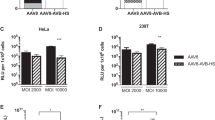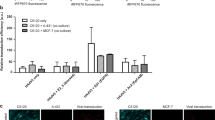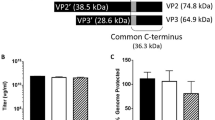Abstract
Adenovirus (Ad) is used as a vector for gene delivery in therapies involving genetic disease, vascular disease, and cancer. The first step for efficient gene transfer is effective virus binding to the target cells. We have found that Ad-mediated gene delivery to multiple cell types is much less efficient compared to epithelial-derived cells. Low gene delivery to nonepithelial cell types was directly correlated to a deficiency of the cellular receptor which mediates Ad binding. To overcome this inefficiency we constructed a new virus, AdPK, that contains a heparin-binding domain that targets the virus to broadly expressed, heparan-containing cellular receptors. AdPK delivers genes to multiple cell types at markedly higher efficiencies than unmodified Ad. Viruses with enhanced attachment characteristics significantly improve gene transfer efficiency and may expand the tissues amenable to efficient Ad-mediated gene therapy.
This is a preview of subscription content, access via your institution
Access options
Subscribe to this journal
Receive 12 print issues and online access
$209.00 per year
only $17.42 per issue
Buy this article
- Purchase on Springer Link
- Instant access to full article PDF
Prices may be subject to local taxes which are calculated during checkout
Similar content being viewed by others
References
Rosenfeld, M.A., Yoshimura, K., Trapnell, B.C., Yoneyama, K., Rosenthal, E.R., Dalemans, W. et al. 1992. In vivo transfer of the human cystic fibrosis transmembrane conductance regulator gene to the airway epithelium. Cell 68: 143–155.
Quantin, B., Perricaudet, L.D., Tajbakhsh, S. and Mandel, J.L. 1992. Adenovirus as an expression vector in muscle cells in vivo. Proc. Natl. Acad. Sci. USA 89: 2581–2584.
Lemarchand, P., Jaffe, H.A., Danel, C., Cid, M.C., Kleinman, H.K., Stratford-Perricaudet, L.D. et al. 1992. Adenovirus-mediated transfer of a recombinant human α 1-antitrypsin cDNA to human endothelial cells. Proc. Natl. Acad. Sci. USA 89: 6482–6486.
Anton, M. and Graham, F.L. 1995. Site-specific recombination mediated by an adenovirus vector expressing the ere recombinase protein: a molecular switch for control of gene expression. J. Virol. 69: 4600–4606.
Le Gal La Salle, G., Robert, J.J., Berrard, S., Ridoux, V., Stratford-Perricaudet, L.D., Perricaudet, M. et al. 1993. An adenovirus vector for gene transfer into neurons and glia in the brain. Science 259: 988–990.
Grubb, B.R., Pickles, R.J., Ye, H., Yankaskas, J.R., Vick, R.N., Engelhardt, J.F. et al. 1994. Inefficient gene transfer by adenovirus vector to cystic fibrosis airway epithelia of mice and humans. Nature 371: 802–806.
Dupuit, F., Zahm, J.-M., Pierrot, D., Brezillon, S., Bonnet, N., Imler, J.-L. et al. 1995. Regenerating cells in human airway surface epithelium represent preferential targets for recombinant adenovirus. Human Gene Therapy 6: 1185–1193.
Acsadi, G., Jani, A., Huard, J., Blaschuk, K., Massie, B., Holland, P. et al. 1994. Cultured human myoblasts and myotubes show markedly different transducibility by replication-defective adenovirus recombinants. Gene Ther. 1: 338–340.
Acsadi, G., Lochmuller, H., Jani, A., Huard, J., Massie, B., Prescott, S. et al. 1996. Dystrophin expression in muscles of mdx mice after adenovirus-mediated in vivo gene transfer. Hum. Gene Ther. 7: 129–140.
March, K.L., Madison, J.E. and Trapnell, B.C. 1995. Pharmocokinetics of adenoviral vector-mediated gene delivery to vascular smooth muscle cells: modulation by poloxamer 407 and implications for cardiovascular gene therapy. Hum. Gene Ther. 6: 41–53.
Heikkila, P., Parpala, T., Lukkarinen, O., Weber, M. and Tryggvason, K. 1996. Adenovirus-mediated gene transfer into kidney glomeruli using an exvivo and in vivo kidney perfusion system—first steps towards gene therapy of Alport syndrome. Gene Ther. 3: 21–27.
Huang, S., Endo, R.I. and Nemerow, G.R. 1995. Upregulation of integrins αvβ3 and αvβ5 on human monocytes and T lymphocytes facilitates adenovirus-mediated gene delivery. J. Virol. 69: 2257–2263.
Wattel, E., Vanrumbeke, M., Abina, M.A., Cambier, N., Preudhomme, C., Haddada, H. et al. 1996. Differential efficacy of adenoviral mediated gene transfer into cells from hematological cell lines and fresh hematological malignancies. Leukemia 10: 171–174.
Pickles, R.J., Barker, P.M., Ye, H. and Boucher, R.C. 1996. Efficient adenovirus-mediated gene transfer to basal but not columnar cells of cartilaginous airway epithelia. Hum. Gene Ther. 7: 921–931.
Philipson, L., Lonberg-Holm, K. and Pettersson, U. 1968. Virus-receptor interaction in an adenovirus system. J. Virol. 2: 1064–1075.
Wickham, T.J., Mathias, P., Cheresh, D.A. and Nemerow, G.R. 1993. Integrins αv7beta;3 and αvβ5 promote adenovirus internalization but not virus attachment. Cell 73: 309–319.
Defer, C., Belin, M.T., Caillet-Boudin, M.L. and Boulanger, P. 1990. Human adenovirus-host cell interactions: comparative study with members of subgroups B and C. J. Virol. 64: 3661–3673.
Stevenson, S.C., Rollence, M., White, B., Weaver, L. and McClelland, A. 1995. Human adenovirus serotypes 3 and 5 bind to two different cellular receptors via the fiber head domain. J. Virol. 69: 2850–2857.
Mathias, P., Wickham, T., Moore, M. and Nemerow, G. 1994. Multiple adenovirus serotypes use αv integrins for infection. J. Virol. 68: 6811–6814.
Jalkanen, M., Jalkanen, S. and Bernfield, M. 1991. Binding of extracellular effector molecules by cell surface proteoglycans, pp. 1–30 in Receptors for extracellular matrix. McDonald, J.A. and Mecham, R.P. (eds.). Academic Press, New York.
Michael, S.I., Hong, J.S., Curiel, D.T. and Engler, J.A. 1995. Addition of a short peptide ligand to the adenovirus fiber protein. Gene Ther. 2: 660–668.
Wickham, T.J., Carrion, M.E. and Kovesdi, I. 1995. Targeting of adenovirus penton base to new receptors through replacement of its RGD motif with other receptor-specific peptide motifs. Gene Ther. 2: 750–756.
Wickham, T.J., Segal, D.M., Roelvink, P.W., Carrion, M.E., Lizonova, A., Lee, G.M. et al. 1996. Targeted adenovirus gene transfer to endothelial and smooth muscle cells by using bispecific antibodies. J. Virol. 70: 6831–6838.
Chroboczek, J. and Jacrot, B. 1987. The sequence of adenovirus fiber: similarities and differences between serotypes 2 and 5. Virology 161: 549–554.
Author information
Authors and Affiliations
Rights and permissions
About this article
Cite this article
Wickham, T., Roelvink, P., Brough, D. et al. Adenovirus targeted to heparan-containing receptors increases its gene delivery efficiency to multiple cell types. Nat Biotechnol 14, 1570–1573 (1996). https://doi.org/10.1038/nbt1196-1570
Received:
Accepted:
Issue Date:
DOI: https://doi.org/10.1038/nbt1196-1570
This article is cited by
-
Polarized AAVR expression determines infectivity by AAV gene therapy vectors
Gene Therapy (2019)
-
HER3 targeting of adenovirus by fiber modification increases infection of breast cancer cells in vitro, but not following intratumoral injection in mice
Cancer Gene Therapy (2012)
-
A rapid protocol for construction and production of high-capacity adenoviral vectors
Nature Protocols (2009)
-
Enhanced nigrostriatal neuron-specific, long-term expression by using neural-specific promoters in combination with targeted gene transfer by modified helper virus-free HSV-1 vector particles
BMC Neuroscience (2008)



